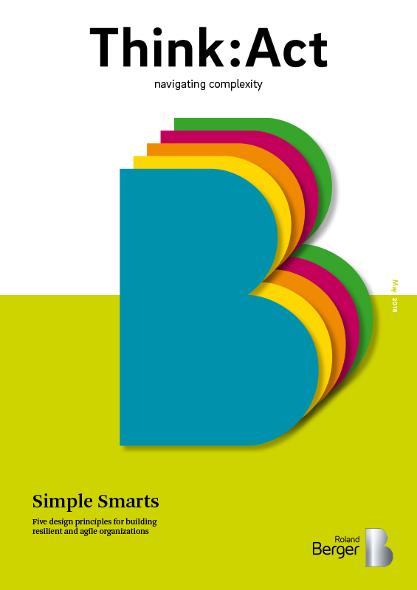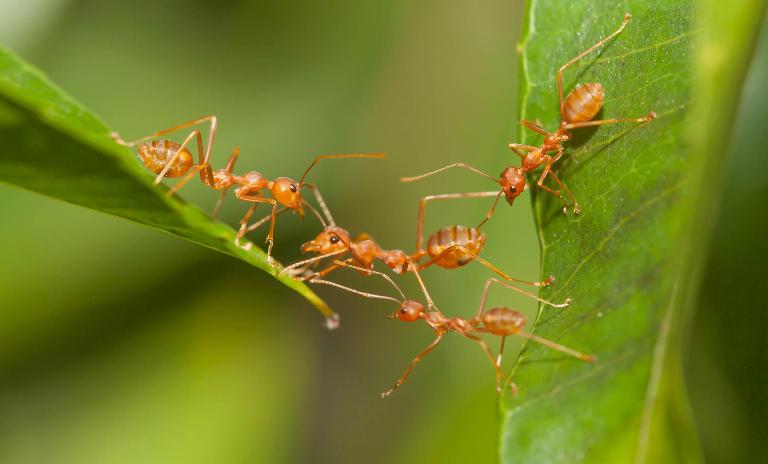Simple smarts spark resilience
![{[downloads[language].preview]}](https://www.rolandberger.com/publications/publication_image/roland_berger_simple_smarts_cover_download_preview.jpg)
Insights gained from the world of ants have inspired us in our formulation of guiding principles for the agile and resilient organization of tomorrow.


If you think a bunch of ants are just a randomly scurrying source of annoyance, think again – an ant colony is in fact a great example for an extremely adaptive and resilient form of organization. And, as such, there's a lot a company can learn from the cooperative behavior of the tiny six-legged invertebrates.
Among their manifold talents, ants develop collective problem-solving strategies when they swarm out looking for food: if one path is blocked, alternative ones are quickly identified and used, with the shortest one automatically becoming the most frequented.
"A handful of modular components that can flexibly reassemble to adapt to any given environment will be more durable and successful than highly specialized units."
When companies heed this lesson, the first crucial point is to allow alternative decision proposals to be submitted from all parts of the organization. Anyone can contribute them, irrespective of status, past successes or any other conditions. The next step is to use hard data to form the strongest hypothesis. If this method does not succeed, a discussion of the quality of the hypotheses ensues and a decision is made on this basis. At the end of the day, the final decision needs the backing of everyone – even of those whose opinion differs.
Ants also teach us that you don't necessarily need a complex organization to deal with complex requirements. Depending on what is needed, worker ants can switch between completely different requirements. An ant that has successfully located a source of food can, at a moment's notice, become a bridge-builder. A scout ant can switch to defending the nest or supplying food to the young. All this happens without hierarchies and with not a hint of central command.
Just like ants, today's employees must group and regroup as flexibly and autonomously as possible in response to new tasks. The lesson is simple: A handful of modular components that can flexibly reassemble to adapt to any given environment will be more durable and successful than highly specialized units.
The examples show that the behavior and organization of ants is based on simple rules, demonstrating that solving complex problems doesn't require complex rules or structures. The insights gained from the world of ants inspired us in our formulation of five guiding principles for the agile company of tomorrow:
Every organization must serve a purpose that is transparent and understandable to both internal members and external stakeholders. If it doesn't have an all-encompassing goal, it's likely that the individual parts will create one for themselves, which in turn fosters a silo mentality. Without a common purpose, the organisation as a whole will eventually fail. The purpose must be as clear and simple as possible, and one of the most important managerial challenges is to communicate it with both clarity and coherence.
The best company decisions are rooted in broad-based discussion and consideration of as many alternatives as possible. Rather than being dictated by leaders, companies should encourage alternative decision proposals to be submitted from all parts of the organization, irrespective of an employee's title, past successes or any other conditions. The important thing is to thoroughly consider decision alternatives from the customer's perspective.
Organizations can no longer afford to keep dedicated units available for every conceivable eventuality. Instead, employees must group and regroup as seemlessly and autonomously as possible in response to new tasks. That also means giving employees both the freedom to make decisions and the resources to get their jobs done. A culture that prioritizes task efficiency must prevail throughout the company.
Managers take on a specific role in Simple Smarts: leadership. They create the environment for the principles to flourish - by ensuring that the company's purpose is anchored in the organization and communicated properly, by inspiring staff and by moderating the hypothesis-based discussion and decision process. On the other hand, Simple Smarts requires managers to renounce their position as omnipotent decision makers. Indeed, they should hardly be involved in daily operations.
Organizations tend to spend a lot of time busying themselves with things that have nothing to do with their actual purpose. Structures, rules and processes emerge that are coherent in themselves (though not even that is always true), but that no longer have much to do with the goals of the organization. Once established, procedures such as regular meetings prove to be immensely durable, even if those who attend see them as futile exercises.

![{[downloads[language].preview]}](https://www.rolandberger.com/publications/publication_image/roland_berger_simple_smarts_cover_download_preview.jpg)
Insights gained from the world of ants have inspired us in our formulation of guiding principles for the agile and resilient organization of tomorrow.
